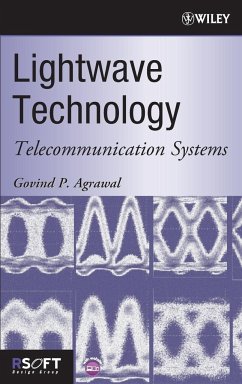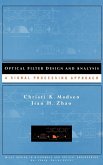- Buch mit Leinen-Einband
- Merkliste
- Auf die Merkliste
- Bewerten Bewerten
- Teilen
- Produkt teilen
- Produkterinnerung
- Produkterinnerung
The state of the art of modern lightwave system design
Recent advances in lightwave technology have led to an explosion of high-speed global information systems throughout the world. Responding to the growth of this exciting new technology, Lightwave Technology provides a comprehensive and up-to-date account of the underlying theory, development, operation, and management of these systems from the perspective of both physics and engineering.
The first independent volume of this two-volume set, Components and Devices, deals with the multitude of silica- and semiconductor-based optical…mehr
Andere Kunden interessierten sich auch für
![LightWave Technology LightWave Technology]() Govind P. AgrawalLightWave Technology174,99 €
Govind P. AgrawalLightWave Technology174,99 €![Noise and Signal Interference in Optical Fiber Transmission Systems Noise and Signal Interference in Optical Fiber Transmission Systems]() Stefano BottacchiNoise and Signal Interference in Optical Fiber Transmission Systems186,99 €
Stefano BottacchiNoise and Signal Interference in Optical Fiber Transmission Systems186,99 €![Optical Filter Design and Analysis Optical Filter Design and Analysis]() Christi K. MadsenOptical Filter Design and Analysis214,99 €
Christi K. MadsenOptical Filter Design and Analysis214,99 €![Erbium-Doped Fiber Amplifiers Erbium-Doped Fiber Amplifiers]() Emmanuel DesurvireErbium-Doped Fiber Amplifiers312,99 €
Emmanuel DesurvireErbium-Doped Fiber Amplifiers312,99 €![Erbium-Doped Fiber Amplifiers Erbium-Doped Fiber Amplifiers]() Emmanuel DesurvireErbium-Doped Fiber Amplifiers135,99 €
Emmanuel DesurvireErbium-Doped Fiber Amplifiers135,99 €![Fiber-Optic Systems for Telecommunications Fiber-Optic Systems for Telecommunications]() Roger L. FreemanFiber-Optic Systems for Telecommunications181,99 €
Roger L. FreemanFiber-Optic Systems for Telecommunications181,99 €![Multi-Gigabit Transmission Over Multimode Optical Fibre Multi-Gigabit Transmission Over Multimode Optical Fibre]() Stefano BottacchiMulti-Gigabit Transmission Over Multimode Optical Fibre195,99 €
Stefano BottacchiMulti-Gigabit Transmission Over Multimode Optical Fibre195,99 €-
-
-
The state of the art of modern lightwave system design
Recent advances in lightwave technology have led to an explosion of high-speed global information systems throughout the world. Responding to the growth of this exciting new technology, Lightwave Technology provides a comprehensive and up-to-date account of the underlying theory, development, operation, and management of these systems from the perspective of both physics and engineering.
The first independent volume of this two-volume set, Components and Devices, deals with the multitude of silica- and semiconductor-based optical devices. This second volume, Telecommunication Systems, helps readers understand the design of modern lightwave systems, with an emphasis on wavelength-division multiplexing (WDM) systems.
_ Two introductory chapters cover topics such as modulation formats and multiplexing techniques used to create optical bit streams
_ Chapters 3 to 5 consider degradation of optical signals through loss, dispersion, and nonlinear impairment during transmission and its corresponding impact on system performance
_ Chapters 6 to 8 provide readers with strategies for managing degradation induced by amplifier noise, fiber dispersion, and various nonlinear effects
_ Chapters 9 and 10 discuss the engineering issues involved in the design of WDM systems and optical networks
Each chapter includes problems that enable readers to engage and test their new knowledge to solve problems. A CD containing illuminating examples based on RSoft Design Group's award-winning OptSim optical communication system simulation software is included with the book to assist readers in understanding design issues. Finally, extensive, up-to-date references at the end of each chapter enable students and researchers to gather more information about the most recent technology breakthroughs and applications.
With its extensive problem sets and straightforward writing style, this is anexcellent textbook for upper-level undergraduate and graduate students. Research scientists and engineers working in lightwave technology will use this text as a problem-solving resource and a reference to additional research papers in the field.
Hinweis: Dieser Artikel kann nur an eine deutsche Lieferadresse ausgeliefert werden.
Recent advances in lightwave technology have led to an explosion of high-speed global information systems throughout the world. Responding to the growth of this exciting new technology, Lightwave Technology provides a comprehensive and up-to-date account of the underlying theory, development, operation, and management of these systems from the perspective of both physics and engineering.
The first independent volume of this two-volume set, Components and Devices, deals with the multitude of silica- and semiconductor-based optical devices. This second volume, Telecommunication Systems, helps readers understand the design of modern lightwave systems, with an emphasis on wavelength-division multiplexing (WDM) systems.
_ Two introductory chapters cover topics such as modulation formats and multiplexing techniques used to create optical bit streams
_ Chapters 3 to 5 consider degradation of optical signals through loss, dispersion, and nonlinear impairment during transmission and its corresponding impact on system performance
_ Chapters 6 to 8 provide readers with strategies for managing degradation induced by amplifier noise, fiber dispersion, and various nonlinear effects
_ Chapters 9 and 10 discuss the engineering issues involved in the design of WDM systems and optical networks
Each chapter includes problems that enable readers to engage and test their new knowledge to solve problems. A CD containing illuminating examples based on RSoft Design Group's award-winning OptSim optical communication system simulation software is included with the book to assist readers in understanding design issues. Finally, extensive, up-to-date references at the end of each chapter enable students and researchers to gather more information about the most recent technology breakthroughs and applications.
With its extensive problem sets and straightforward writing style, this is anexcellent textbook for upper-level undergraduate and graduate students. Research scientists and engineers working in lightwave technology will use this text as a problem-solving resource and a reference to additional research papers in the field.
Hinweis: Dieser Artikel kann nur an eine deutsche Lieferadresse ausgeliefert werden.
Produktdetails
- Produktdetails
- Verlag: Wiley & Sons
- 1. Auflage
- Seitenzahl: 480
- Erscheinungstermin: 23. Juni 2005
- Englisch
- Abmessung: 240mm x 161mm x 30mm
- Gewicht: 785g
- ISBN-13: 9780471215721
- ISBN-10: 0471215724
- Artikelnr.: 14839412
- Herstellerkennzeichnung
- Libri GmbH
- Europaallee 1
- 36244 Bad Hersfeld
- gpsr@libri.de
- Verlag: Wiley & Sons
- 1. Auflage
- Seitenzahl: 480
- Erscheinungstermin: 23. Juni 2005
- Englisch
- Abmessung: 240mm x 161mm x 30mm
- Gewicht: 785g
- ISBN-13: 9780471215721
- ISBN-10: 0471215724
- Artikelnr.: 14839412
- Herstellerkennzeichnung
- Libri GmbH
- Europaallee 1
- 36244 Bad Hersfeld
- gpsr@libri.de
GOVIND P. AGRAWAL, PhD, is a Professor of Optics at The Institute of Optics, University of Rochester, New York, and a Fellow of the Optical Society of America and the IEEE. Internationally recognized as an expert in his field, Dr. Agrawal has authored or coauthored more than 300 research papers, books, and monographs.
Preface
1 Introduction 1
1.1 Evolution of Lightwave Systems 1
1.2 Components of a Lightwave System 7
1.2.1 Optical Transmitters 7
1.2.2 Communication Channel 8
1.2.3 Optical Receivers 9
1.3 Electrical Signals 11
1.3.1 Analog and Digital Signals 11
1.3.2 Advantages of Digital Format 12
1.3.3 Analog to Digital Conversion 13
1.4 Channel Multiplexing 16
1.4.1 Time-Division Multiplexing 16
1.4.2 Frequency-Division Multiplexing 18
1.4.3 Code-Division Multiplexing 20
Problems 21
References 22
2 Optical Signal Generation 26
2.1 Modulation Formats 26
2.1.1 ASK Format 28
2.1.2 PSK Format 30
2.1.3 FSK Format 31
2.2 Digital Data Formats 32
2.2.1 Nonreturn-to-Zero Format 33
2.2.2 Return-to-Zero Format 34
2.2.3 Power Spectral Density 34
2.3 Bit-Stream Generation 37
2.3.1 NRZ Transmitters 37
2.3.2 RZ Transmitters 38
2.3.3 Modified RZ Transmitters 40
2.3.4 DPSK Transmitters and Receivers 46
2.4 Transmitter Design 47
2.4.1 Coupling Losses and Output Stability 48
2.4.2 Wavelength Stability and Tunability 50
2.4.3 Monolithic Integration 53
2.4.4 Reliability and Packaging 55
Problems 57
References 58
3 Signal Propagation in Fibers 63
3.1 Basic Propagation Equation 63
3.2 Impact of Fiber Losses 67
3.2.1 Loss Compensation 67
3.2.2 Lumped and Distributed Amplification 69
3.3 Impact of Fiber Dispersion 71
3.3.1 Chirped Gaussian Pulses 71
3.3.2 Pulses of Arbitrary Shape 74
3.3.3 Effects of Source Spectrum 76
3.3.4 Limitations on the Bit Rate 78
3.3.5 Dispersion compensation 81
3.4 Polarization-Mode Dispersion 82
3.4.1 Fibers with Constant Birefringence 83
3.4.2 Fibers with Random Birefringence 84
3.4.3 Jones-Matrix Formalism 87
3.4.4 Stokes-Space Description 89
3.4.5 Statistics of PMD 92
3.4.6 PMD-Induced Pulse Broadening 95
3.4.7 Higher-Order PMD Effects 96
3.5 Polarization-Dependent Losses 98
3.5.1 PDL Vector and Its Statistics 99
3.5.2 PDL-lnduced Pulse Distortion 101
Problems 103
References 104
4 Nonlinear Impairments 107
4.1 Self-Phase Modulation 107
4.1.1 Nonlinear Phase Shift 108
4.1.2 Spectral Broadening and Narrowing 111
4.1.3 Effects of Fiber Dispersion 113
4.1.4 Modulation Instability 114
4.2 Cross-Phase Modulation 117
4.2.1 XPM-Induced Phase Shift 117
4.2.2 Effects of Group-Velocity Mismatch 119
4.2.3 Effects of Group-Velocity Dispersion 121
4.2.4 Control of XPM Interaction 124
4.3 Four-Wave Mixing 125
4.3.1 FWM Efficiency 126
4.3.2 Control of FWM 128
4.4 Stimulated Raman Scattering 130
4.4.1 Raman-Gain Spectrum 131
4.4.2 Raman Threshold 132
4.5 Stimulated Brillouin Scattering 134
4.5.1 Brillouin Threshold 134
4.5.2 Control of SBS 136
4.6 Nonlinear Pulse Propagation 137
4.6.1 Moment Method 137
4.6.2 Variational Method 139
4.6.3 Specific Analytic Solutions 140
4.7 Polarization Effects 142
4.7.1 Vector NLS equation 142
4.7.2 Manakov Equation 144
Problems 145
References 146
5 Signal Recovery and Noise 151
5.1 Noise Sources 151
5.1.1 Shot Noise 152
5.1.2 Thermal Noise 153
5.2 Signal-to-Noise Ratio 154
5.2.1 Receivers with a p-i-n Photodiode 155
5.2.2 APD Receivers 156
5.3 Receiver Sensitivity 159
5.3.1 Bit-Error Rate 160
5.3.2 Minimum Average Power 163
5.3.3 Quantum Limit of Photodetection 165
5.4 Sensitivity Degradation 166
5.4.1 Finite Extinction Ratio 166
5.4.2 Intensity Noise of Lasers 168
5.4.3 Dispersive Pulse Broadening 170
5.4.4 Frequency Chirping 171
5.4.5 Timing Jitter 172
5.4.6 Eye-Closure Penalty 175
5.5 Forward Error Correction 176
5.5.1 Error-Correcting Codes 177
5.5.2 Coding Gain 177
5.5.3 Optimum Coding Overhead 178
Problems 181
References 182
6 Optical Amplifier Noise 185
6.1 Origin of Amplifier Noise 185
6.1.1 EDFA Noise 186
6.1.2 Distributed Amplification 189
6.2 Optical SNR 190
6.2.1 Lumped Amplification 190
6.2.2 Distributed Amplification 19i
6.3 Electrical SNR 193
6.3.1 ASE-Induced Current Fluctuations 193
6.3.2 Impact of ASE on SNR 194
6.3.3 Noise Figure of Distributed Amplifiers 196
6.3.4 Noise Buildup in an Amplifier Chain 198
6.4 Receiver Sensitivity and Q Factor 199
6.4.1 Bit-Error Rate 199
6.4.2 Non-Gaussian Receiver Noise 201
6.4.3 Relation between Q Factor and Optical SNR 202
6.5 Role of Dispersive and Nonlinear Effects 204
6.5.1 Noise Growth through Modulation Instability 204
6.5.2 Noise-Induced Signal Degradation 207
6.5.3 Noise-Induced Energy Fluctuations 210
6.5.4 Noise-Induced Frequency Fluctuations 211
6.5.5 Noise-Induced Timing Jitter 213
6.5.6 Jitter Reduction through Distributed Amplification 214
6.6 Periodically Amplified Lightwave Systems 216
6.6.1 Numerical Approach 216
6.6.2 Optimum Launched Power 219
Problems 221
References 222
7 Dispersion Management 225
7.1 Dispersion Problem and Its Solution 225
7.2 Dispersion-Compensating Fibers 227
7.2.1 Conditions for Dispersion Compensation 228
7.2.2 Dispersion Maps 229
7.2.3 DCF Designs 231
7.2.4 Reverse-Dispersion Fibers 234
7.3 Dispersion-Equalizing Filters 235
7.3.1 Gires-Toumois Filters 235
7.3.2 Mac h-Zehnder Filters 237
7.3.3 Other All-Pass Filters 239
7.4 Fiber Bragg Gratings 240
7.4.1 Constant-Period Gratings 240
7.4.2 Chirped Fiber Gratings 243
7.4.3 Sampled Gratings 246
7.5 Optical Phase Conjugation 250
7.5.1 Principle of Operation 250
7.5.2 Compensation of Self-Phase Modulation 250
7.5.3 Generation of Phase-Conjugated Signal 253
7.6 Other Schemes 256
7.6.1 Prechirp Technique 256
7.6.2 Novel Coding Techniques 259
7.6.3 Nonlinear Prechirp Techniques 260
7.6.4 Electronic Compensation Techniques 261
7.7 High-Speed Lightwave Systems 262
7.7.1 Tunable Dispersion Compensation 262
7.7.2 Higher-Order Dispersion Management 267
7.7.3 PMD Compensation 270
Problems 274
References 276
8 Nonlinearity Management 284
8.1 Role of Fiber Nonlinearity 284
8.1.1 System Design Issues 285
8.1.2 Semianalytic Approach 289
8.1.3 Soliton and Pseudo-linear Regimes 291
8.2 Solitons in Optical Fibers 293
8.2.1 Properties of Optical Solitons 293
8.2.2 Loss-Managed Solitons 297
8.3 Dispersion-Managed Solitons 301
8.3.1 Dispersion-Decreasing Fibers 301
8.3.2 Periodic Dispersion Maps 302
8.3.3 Design Issues 305
8.3.4 Timing Jitter 308
8.3.5 Control of Timing Jitter 310
8.4 Pseudo-linear Lightwave Systems 314
8.4.1 Intrachannel Nonlinear Effects 314
8.4.2 Intrachannel XPM 316
8.4.3 Intrachannel FWM 320
8.5 Control of Intrachannel Nonlinear Effects 324
8.5.1 Optimization of Dispersion Maps 324
8.5.2 Phase-A Item at ion Techniques 328
8.5.3 Polarization Bit Interleaving 330
8.6 High-Speed Lightwave Systems 332
8.6.1 OTDM Transmitters and Receivers 332
8.6.2 Performance of OTDM System 335
Problems 337
References 339
9 WDM Systems 346
9.1 Basic WDM Scheme 346
9.1.1 System Capacity and Spectral Efficiency 347
9.1.2 Bandwidth and Capacity of WDM Systems 348
9.2 Linear Degradation Mechanisms 351
9.2.1 Out-of-Band Linear Crosstalk 351
9.2.2 In-Band Linear Crosstalk 353
9.2.3 Filter-Induced Signal Distortion 356
9.3 Nonlinear Crosstalk 357
9.3.1 Raman Crosstalk 358
9.3.2 Four-Wave Mixing 363
9.4 Cross-Phase Modulation 366
9.4.1 Amplitude Fluctuations 366
9.4.2 Timing Jitter 369
9.5 Control of Nonlinear Effects 374
9.5.1 Optimization of Dispersion Maps 374
9.5.2 Use of Raman Amplification 378
9.5.3 Polarization Interleaving of Channels 381
9.5.4 Use of DPSK Formal 383
9.6 Major Design Issues 385
9.6.1 Spectral Efficiency 386
9.6.2 Dispersion Fluctuations 391
9.6.3 PMD and Polarization-Dependent Losses 393
9.6.4 Wavelength Stability and Other Issues 395
Problems 397
References 398
10 Optical Networks 404
10.1 Network Architecture and Topologies 404
10.1.1 Wide-Area Networks 404
10.1.2 Metropolitan-Area Networks 406
10.1.3 Local-Area Networks 407
10.2 Network Protocols and Layers 409
10.24 Evolution of Protocols 409
10.2.2 Evolution of WDM Networks 410
10.2.3 Network Planes 412
10.3 Wavelength-Routing Networks 413
10.34 Wavelength Switching and Its Limitations 414
10.3.2 Architecture of Optical Cross-Connects 414
10.3.3 Switching Technologies for Cross-Connects 417
10.4 Packet-Switched Networks 418
10.44 Optical Label Swapping 419
10.4.2 Techniques for Label Coding 420
10.4.3 Contention Resolution 424
10.5 Other Routing Techniques 425
10.54 Optical Burst Switching 426
10.5.2 Photonic Slot Routing 427
10.5.3 High-Speed TDM Networks 429
10.6 Distribution and Access Networks 431
10.64 Broadcast-and-Select Networks 431
10.6.2 Passive Optical Networks 433
Problems 436
References 437
Appendix A System of Units 442
Appendix B Software Package 444
Appendix C Acronyms 446
Index 449
1 Introduction 1
1.1 Evolution of Lightwave Systems 1
1.2 Components of a Lightwave System 7
1.2.1 Optical Transmitters 7
1.2.2 Communication Channel 8
1.2.3 Optical Receivers 9
1.3 Electrical Signals 11
1.3.1 Analog and Digital Signals 11
1.3.2 Advantages of Digital Format 12
1.3.3 Analog to Digital Conversion 13
1.4 Channel Multiplexing 16
1.4.1 Time-Division Multiplexing 16
1.4.2 Frequency-Division Multiplexing 18
1.4.3 Code-Division Multiplexing 20
Problems 21
References 22
2 Optical Signal Generation 26
2.1 Modulation Formats 26
2.1.1 ASK Format 28
2.1.2 PSK Format 30
2.1.3 FSK Format 31
2.2 Digital Data Formats 32
2.2.1 Nonreturn-to-Zero Format 33
2.2.2 Return-to-Zero Format 34
2.2.3 Power Spectral Density 34
2.3 Bit-Stream Generation 37
2.3.1 NRZ Transmitters 37
2.3.2 RZ Transmitters 38
2.3.3 Modified RZ Transmitters 40
2.3.4 DPSK Transmitters and Receivers 46
2.4 Transmitter Design 47
2.4.1 Coupling Losses and Output Stability 48
2.4.2 Wavelength Stability and Tunability 50
2.4.3 Monolithic Integration 53
2.4.4 Reliability and Packaging 55
Problems 57
References 58
3 Signal Propagation in Fibers 63
3.1 Basic Propagation Equation 63
3.2 Impact of Fiber Losses 67
3.2.1 Loss Compensation 67
3.2.2 Lumped and Distributed Amplification 69
3.3 Impact of Fiber Dispersion 71
3.3.1 Chirped Gaussian Pulses 71
3.3.2 Pulses of Arbitrary Shape 74
3.3.3 Effects of Source Spectrum 76
3.3.4 Limitations on the Bit Rate 78
3.3.5 Dispersion compensation 81
3.4 Polarization-Mode Dispersion 82
3.4.1 Fibers with Constant Birefringence 83
3.4.2 Fibers with Random Birefringence 84
3.4.3 Jones-Matrix Formalism 87
3.4.4 Stokes-Space Description 89
3.4.5 Statistics of PMD 92
3.4.6 PMD-Induced Pulse Broadening 95
3.4.7 Higher-Order PMD Effects 96
3.5 Polarization-Dependent Losses 98
3.5.1 PDL Vector and Its Statistics 99
3.5.2 PDL-lnduced Pulse Distortion 101
Problems 103
References 104
4 Nonlinear Impairments 107
4.1 Self-Phase Modulation 107
4.1.1 Nonlinear Phase Shift 108
4.1.2 Spectral Broadening and Narrowing 111
4.1.3 Effects of Fiber Dispersion 113
4.1.4 Modulation Instability 114
4.2 Cross-Phase Modulation 117
4.2.1 XPM-Induced Phase Shift 117
4.2.2 Effects of Group-Velocity Mismatch 119
4.2.3 Effects of Group-Velocity Dispersion 121
4.2.4 Control of XPM Interaction 124
4.3 Four-Wave Mixing 125
4.3.1 FWM Efficiency 126
4.3.2 Control of FWM 128
4.4 Stimulated Raman Scattering 130
4.4.1 Raman-Gain Spectrum 131
4.4.2 Raman Threshold 132
4.5 Stimulated Brillouin Scattering 134
4.5.1 Brillouin Threshold 134
4.5.2 Control of SBS 136
4.6 Nonlinear Pulse Propagation 137
4.6.1 Moment Method 137
4.6.2 Variational Method 139
4.6.3 Specific Analytic Solutions 140
4.7 Polarization Effects 142
4.7.1 Vector NLS equation 142
4.7.2 Manakov Equation 144
Problems 145
References 146
5 Signal Recovery and Noise 151
5.1 Noise Sources 151
5.1.1 Shot Noise 152
5.1.2 Thermal Noise 153
5.2 Signal-to-Noise Ratio 154
5.2.1 Receivers with a p-i-n Photodiode 155
5.2.2 APD Receivers 156
5.3 Receiver Sensitivity 159
5.3.1 Bit-Error Rate 160
5.3.2 Minimum Average Power 163
5.3.3 Quantum Limit of Photodetection 165
5.4 Sensitivity Degradation 166
5.4.1 Finite Extinction Ratio 166
5.4.2 Intensity Noise of Lasers 168
5.4.3 Dispersive Pulse Broadening 170
5.4.4 Frequency Chirping 171
5.4.5 Timing Jitter 172
5.4.6 Eye-Closure Penalty 175
5.5 Forward Error Correction 176
5.5.1 Error-Correcting Codes 177
5.5.2 Coding Gain 177
5.5.3 Optimum Coding Overhead 178
Problems 181
References 182
6 Optical Amplifier Noise 185
6.1 Origin of Amplifier Noise 185
6.1.1 EDFA Noise 186
6.1.2 Distributed Amplification 189
6.2 Optical SNR 190
6.2.1 Lumped Amplification 190
6.2.2 Distributed Amplification 19i
6.3 Electrical SNR 193
6.3.1 ASE-Induced Current Fluctuations 193
6.3.2 Impact of ASE on SNR 194
6.3.3 Noise Figure of Distributed Amplifiers 196
6.3.4 Noise Buildup in an Amplifier Chain 198
6.4 Receiver Sensitivity and Q Factor 199
6.4.1 Bit-Error Rate 199
6.4.2 Non-Gaussian Receiver Noise 201
6.4.3 Relation between Q Factor and Optical SNR 202
6.5 Role of Dispersive and Nonlinear Effects 204
6.5.1 Noise Growth through Modulation Instability 204
6.5.2 Noise-Induced Signal Degradation 207
6.5.3 Noise-Induced Energy Fluctuations 210
6.5.4 Noise-Induced Frequency Fluctuations 211
6.5.5 Noise-Induced Timing Jitter 213
6.5.6 Jitter Reduction through Distributed Amplification 214
6.6 Periodically Amplified Lightwave Systems 216
6.6.1 Numerical Approach 216
6.6.2 Optimum Launched Power 219
Problems 221
References 222
7 Dispersion Management 225
7.1 Dispersion Problem and Its Solution 225
7.2 Dispersion-Compensating Fibers 227
7.2.1 Conditions for Dispersion Compensation 228
7.2.2 Dispersion Maps 229
7.2.3 DCF Designs 231
7.2.4 Reverse-Dispersion Fibers 234
7.3 Dispersion-Equalizing Filters 235
7.3.1 Gires-Toumois Filters 235
7.3.2 Mac h-Zehnder Filters 237
7.3.3 Other All-Pass Filters 239
7.4 Fiber Bragg Gratings 240
7.4.1 Constant-Period Gratings 240
7.4.2 Chirped Fiber Gratings 243
7.4.3 Sampled Gratings 246
7.5 Optical Phase Conjugation 250
7.5.1 Principle of Operation 250
7.5.2 Compensation of Self-Phase Modulation 250
7.5.3 Generation of Phase-Conjugated Signal 253
7.6 Other Schemes 256
7.6.1 Prechirp Technique 256
7.6.2 Novel Coding Techniques 259
7.6.3 Nonlinear Prechirp Techniques 260
7.6.4 Electronic Compensation Techniques 261
7.7 High-Speed Lightwave Systems 262
7.7.1 Tunable Dispersion Compensation 262
7.7.2 Higher-Order Dispersion Management 267
7.7.3 PMD Compensation 270
Problems 274
References 276
8 Nonlinearity Management 284
8.1 Role of Fiber Nonlinearity 284
8.1.1 System Design Issues 285
8.1.2 Semianalytic Approach 289
8.1.3 Soliton and Pseudo-linear Regimes 291
8.2 Solitons in Optical Fibers 293
8.2.1 Properties of Optical Solitons 293
8.2.2 Loss-Managed Solitons 297
8.3 Dispersion-Managed Solitons 301
8.3.1 Dispersion-Decreasing Fibers 301
8.3.2 Periodic Dispersion Maps 302
8.3.3 Design Issues 305
8.3.4 Timing Jitter 308
8.3.5 Control of Timing Jitter 310
8.4 Pseudo-linear Lightwave Systems 314
8.4.1 Intrachannel Nonlinear Effects 314
8.4.2 Intrachannel XPM 316
8.4.3 Intrachannel FWM 320
8.5 Control of Intrachannel Nonlinear Effects 324
8.5.1 Optimization of Dispersion Maps 324
8.5.2 Phase-A Item at ion Techniques 328
8.5.3 Polarization Bit Interleaving 330
8.6 High-Speed Lightwave Systems 332
8.6.1 OTDM Transmitters and Receivers 332
8.6.2 Performance of OTDM System 335
Problems 337
References 339
9 WDM Systems 346
9.1 Basic WDM Scheme 346
9.1.1 System Capacity and Spectral Efficiency 347
9.1.2 Bandwidth and Capacity of WDM Systems 348
9.2 Linear Degradation Mechanisms 351
9.2.1 Out-of-Band Linear Crosstalk 351
9.2.2 In-Band Linear Crosstalk 353
9.2.3 Filter-Induced Signal Distortion 356
9.3 Nonlinear Crosstalk 357
9.3.1 Raman Crosstalk 358
9.3.2 Four-Wave Mixing 363
9.4 Cross-Phase Modulation 366
9.4.1 Amplitude Fluctuations 366
9.4.2 Timing Jitter 369
9.5 Control of Nonlinear Effects 374
9.5.1 Optimization of Dispersion Maps 374
9.5.2 Use of Raman Amplification 378
9.5.3 Polarization Interleaving of Channels 381
9.5.4 Use of DPSK Formal 383
9.6 Major Design Issues 385
9.6.1 Spectral Efficiency 386
9.6.2 Dispersion Fluctuations 391
9.6.3 PMD and Polarization-Dependent Losses 393
9.6.4 Wavelength Stability and Other Issues 395
Problems 397
References 398
10 Optical Networks 404
10.1 Network Architecture and Topologies 404
10.1.1 Wide-Area Networks 404
10.1.2 Metropolitan-Area Networks 406
10.1.3 Local-Area Networks 407
10.2 Network Protocols and Layers 409
10.24 Evolution of Protocols 409
10.2.2 Evolution of WDM Networks 410
10.2.3 Network Planes 412
10.3 Wavelength-Routing Networks 413
10.34 Wavelength Switching and Its Limitations 414
10.3.2 Architecture of Optical Cross-Connects 414
10.3.3 Switching Technologies for Cross-Connects 417
10.4 Packet-Switched Networks 418
10.44 Optical Label Swapping 419
10.4.2 Techniques for Label Coding 420
10.4.3 Contention Resolution 424
10.5 Other Routing Techniques 425
10.54 Optical Burst Switching 426
10.5.2 Photonic Slot Routing 427
10.5.3 High-Speed TDM Networks 429
10.6 Distribution and Access Networks 431
10.64 Broadcast-and-Select Networks 431
10.6.2 Passive Optical Networks 433
Problems 436
References 437
Appendix A System of Units 442
Appendix B Software Package 444
Appendix C Acronyms 446
Index 449
Preface
1 Introduction 1
1.1 Evolution of Lightwave Systems 1
1.2 Components of a Lightwave System 7
1.2.1 Optical Transmitters 7
1.2.2 Communication Channel 8
1.2.3 Optical Receivers 9
1.3 Electrical Signals 11
1.3.1 Analog and Digital Signals 11
1.3.2 Advantages of Digital Format 12
1.3.3 Analog to Digital Conversion 13
1.4 Channel Multiplexing 16
1.4.1 Time-Division Multiplexing 16
1.4.2 Frequency-Division Multiplexing 18
1.4.3 Code-Division Multiplexing 20
Problems 21
References 22
2 Optical Signal Generation 26
2.1 Modulation Formats 26
2.1.1 ASK Format 28
2.1.2 PSK Format 30
2.1.3 FSK Format 31
2.2 Digital Data Formats 32
2.2.1 Nonreturn-to-Zero Format 33
2.2.2 Return-to-Zero Format 34
2.2.3 Power Spectral Density 34
2.3 Bit-Stream Generation 37
2.3.1 NRZ Transmitters 37
2.3.2 RZ Transmitters 38
2.3.3 Modified RZ Transmitters 40
2.3.4 DPSK Transmitters and Receivers 46
2.4 Transmitter Design 47
2.4.1 Coupling Losses and Output Stability 48
2.4.2 Wavelength Stability and Tunability 50
2.4.3 Monolithic Integration 53
2.4.4 Reliability and Packaging 55
Problems 57
References 58
3 Signal Propagation in Fibers 63
3.1 Basic Propagation Equation 63
3.2 Impact of Fiber Losses 67
3.2.1 Loss Compensation 67
3.2.2 Lumped and Distributed Amplification 69
3.3 Impact of Fiber Dispersion 71
3.3.1 Chirped Gaussian Pulses 71
3.3.2 Pulses of Arbitrary Shape 74
3.3.3 Effects of Source Spectrum 76
3.3.4 Limitations on the Bit Rate 78
3.3.5 Dispersion compensation 81
3.4 Polarization-Mode Dispersion 82
3.4.1 Fibers with Constant Birefringence 83
3.4.2 Fibers with Random Birefringence 84
3.4.3 Jones-Matrix Formalism 87
3.4.4 Stokes-Space Description 89
3.4.5 Statistics of PMD 92
3.4.6 PMD-Induced Pulse Broadening 95
3.4.7 Higher-Order PMD Effects 96
3.5 Polarization-Dependent Losses 98
3.5.1 PDL Vector and Its Statistics 99
3.5.2 PDL-lnduced Pulse Distortion 101
Problems 103
References 104
4 Nonlinear Impairments 107
4.1 Self-Phase Modulation 107
4.1.1 Nonlinear Phase Shift 108
4.1.2 Spectral Broadening and Narrowing 111
4.1.3 Effects of Fiber Dispersion 113
4.1.4 Modulation Instability 114
4.2 Cross-Phase Modulation 117
4.2.1 XPM-Induced Phase Shift 117
4.2.2 Effects of Group-Velocity Mismatch 119
4.2.3 Effects of Group-Velocity Dispersion 121
4.2.4 Control of XPM Interaction 124
4.3 Four-Wave Mixing 125
4.3.1 FWM Efficiency 126
4.3.2 Control of FWM 128
4.4 Stimulated Raman Scattering 130
4.4.1 Raman-Gain Spectrum 131
4.4.2 Raman Threshold 132
4.5 Stimulated Brillouin Scattering 134
4.5.1 Brillouin Threshold 134
4.5.2 Control of SBS 136
4.6 Nonlinear Pulse Propagation 137
4.6.1 Moment Method 137
4.6.2 Variational Method 139
4.6.3 Specific Analytic Solutions 140
4.7 Polarization Effects 142
4.7.1 Vector NLS equation 142
4.7.2 Manakov Equation 144
Problems 145
References 146
5 Signal Recovery and Noise 151
5.1 Noise Sources 151
5.1.1 Shot Noise 152
5.1.2 Thermal Noise 153
5.2 Signal-to-Noise Ratio 154
5.2.1 Receivers with a p-i-n Photodiode 155
5.2.2 APD Receivers 156
5.3 Receiver Sensitivity 159
5.3.1 Bit-Error Rate 160
5.3.2 Minimum Average Power 163
5.3.3 Quantum Limit of Photodetection 165
5.4 Sensitivity Degradation 166
5.4.1 Finite Extinction Ratio 166
5.4.2 Intensity Noise of Lasers 168
5.4.3 Dispersive Pulse Broadening 170
5.4.4 Frequency Chirping 171
5.4.5 Timing Jitter 172
5.4.6 Eye-Closure Penalty 175
5.5 Forward Error Correction 176
5.5.1 Error-Correcting Codes 177
5.5.2 Coding Gain 177
5.5.3 Optimum Coding Overhead 178
Problems 181
References 182
6 Optical Amplifier Noise 185
6.1 Origin of Amplifier Noise 185
6.1.1 EDFA Noise 186
6.1.2 Distributed Amplification 189
6.2 Optical SNR 190
6.2.1 Lumped Amplification 190
6.2.2 Distributed Amplification 19i
6.3 Electrical SNR 193
6.3.1 ASE-Induced Current Fluctuations 193
6.3.2 Impact of ASE on SNR 194
6.3.3 Noise Figure of Distributed Amplifiers 196
6.3.4 Noise Buildup in an Amplifier Chain 198
6.4 Receiver Sensitivity and Q Factor 199
6.4.1 Bit-Error Rate 199
6.4.2 Non-Gaussian Receiver Noise 201
6.4.3 Relation between Q Factor and Optical SNR 202
6.5 Role of Dispersive and Nonlinear Effects 204
6.5.1 Noise Growth through Modulation Instability 204
6.5.2 Noise-Induced Signal Degradation 207
6.5.3 Noise-Induced Energy Fluctuations 210
6.5.4 Noise-Induced Frequency Fluctuations 211
6.5.5 Noise-Induced Timing Jitter 213
6.5.6 Jitter Reduction through Distributed Amplification 214
6.6 Periodically Amplified Lightwave Systems 216
6.6.1 Numerical Approach 216
6.6.2 Optimum Launched Power 219
Problems 221
References 222
7 Dispersion Management 225
7.1 Dispersion Problem and Its Solution 225
7.2 Dispersion-Compensating Fibers 227
7.2.1 Conditions for Dispersion Compensation 228
7.2.2 Dispersion Maps 229
7.2.3 DCF Designs 231
7.2.4 Reverse-Dispersion Fibers 234
7.3 Dispersion-Equalizing Filters 235
7.3.1 Gires-Toumois Filters 235
7.3.2 Mac h-Zehnder Filters 237
7.3.3 Other All-Pass Filters 239
7.4 Fiber Bragg Gratings 240
7.4.1 Constant-Period Gratings 240
7.4.2 Chirped Fiber Gratings 243
7.4.3 Sampled Gratings 246
7.5 Optical Phase Conjugation 250
7.5.1 Principle of Operation 250
7.5.2 Compensation of Self-Phase Modulation 250
7.5.3 Generation of Phase-Conjugated Signal 253
7.6 Other Schemes 256
7.6.1 Prechirp Technique 256
7.6.2 Novel Coding Techniques 259
7.6.3 Nonlinear Prechirp Techniques 260
7.6.4 Electronic Compensation Techniques 261
7.7 High-Speed Lightwave Systems 262
7.7.1 Tunable Dispersion Compensation 262
7.7.2 Higher-Order Dispersion Management 267
7.7.3 PMD Compensation 270
Problems 274
References 276
8 Nonlinearity Management 284
8.1 Role of Fiber Nonlinearity 284
8.1.1 System Design Issues 285
8.1.2 Semianalytic Approach 289
8.1.3 Soliton and Pseudo-linear Regimes 291
8.2 Solitons in Optical Fibers 293
8.2.1 Properties of Optical Solitons 293
8.2.2 Loss-Managed Solitons 297
8.3 Dispersion-Managed Solitons 301
8.3.1 Dispersion-Decreasing Fibers 301
8.3.2 Periodic Dispersion Maps 302
8.3.3 Design Issues 305
8.3.4 Timing Jitter 308
8.3.5 Control of Timing Jitter 310
8.4 Pseudo-linear Lightwave Systems 314
8.4.1 Intrachannel Nonlinear Effects 314
8.4.2 Intrachannel XPM 316
8.4.3 Intrachannel FWM 320
8.5 Control of Intrachannel Nonlinear Effects 324
8.5.1 Optimization of Dispersion Maps 324
8.5.2 Phase-A Item at ion Techniques 328
8.5.3 Polarization Bit Interleaving 330
8.6 High-Speed Lightwave Systems 332
8.6.1 OTDM Transmitters and Receivers 332
8.6.2 Performance of OTDM System 335
Problems 337
References 339
9 WDM Systems 346
9.1 Basic WDM Scheme 346
9.1.1 System Capacity and Spectral Efficiency 347
9.1.2 Bandwidth and Capacity of WDM Systems 348
9.2 Linear Degradation Mechanisms 351
9.2.1 Out-of-Band Linear Crosstalk 351
9.2.2 In-Band Linear Crosstalk 353
9.2.3 Filter-Induced Signal Distortion 356
9.3 Nonlinear Crosstalk 357
9.3.1 Raman Crosstalk 358
9.3.2 Four-Wave Mixing 363
9.4 Cross-Phase Modulation 366
9.4.1 Amplitude Fluctuations 366
9.4.2 Timing Jitter 369
9.5 Control of Nonlinear Effects 374
9.5.1 Optimization of Dispersion Maps 374
9.5.2 Use of Raman Amplification 378
9.5.3 Polarization Interleaving of Channels 381
9.5.4 Use of DPSK Formal 383
9.6 Major Design Issues 385
9.6.1 Spectral Efficiency 386
9.6.2 Dispersion Fluctuations 391
9.6.3 PMD and Polarization-Dependent Losses 393
9.6.4 Wavelength Stability and Other Issues 395
Problems 397
References 398
10 Optical Networks 404
10.1 Network Architecture and Topologies 404
10.1.1 Wide-Area Networks 404
10.1.2 Metropolitan-Area Networks 406
10.1.3 Local-Area Networks 407
10.2 Network Protocols and Layers 409
10.24 Evolution of Protocols 409
10.2.2 Evolution of WDM Networks 410
10.2.3 Network Planes 412
10.3 Wavelength-Routing Networks 413
10.34 Wavelength Switching and Its Limitations 414
10.3.2 Architecture of Optical Cross-Connects 414
10.3.3 Switching Technologies for Cross-Connects 417
10.4 Packet-Switched Networks 418
10.44 Optical Label Swapping 419
10.4.2 Techniques for Label Coding 420
10.4.3 Contention Resolution 424
10.5 Other Routing Techniques 425
10.54 Optical Burst Switching 426
10.5.2 Photonic Slot Routing 427
10.5.3 High-Speed TDM Networks 429
10.6 Distribution and Access Networks 431
10.64 Broadcast-and-Select Networks 431
10.6.2 Passive Optical Networks 433
Problems 436
References 437
Appendix A System of Units 442
Appendix B Software Package 444
Appendix C Acronyms 446
Index 449
1 Introduction 1
1.1 Evolution of Lightwave Systems 1
1.2 Components of a Lightwave System 7
1.2.1 Optical Transmitters 7
1.2.2 Communication Channel 8
1.2.3 Optical Receivers 9
1.3 Electrical Signals 11
1.3.1 Analog and Digital Signals 11
1.3.2 Advantages of Digital Format 12
1.3.3 Analog to Digital Conversion 13
1.4 Channel Multiplexing 16
1.4.1 Time-Division Multiplexing 16
1.4.2 Frequency-Division Multiplexing 18
1.4.3 Code-Division Multiplexing 20
Problems 21
References 22
2 Optical Signal Generation 26
2.1 Modulation Formats 26
2.1.1 ASK Format 28
2.1.2 PSK Format 30
2.1.3 FSK Format 31
2.2 Digital Data Formats 32
2.2.1 Nonreturn-to-Zero Format 33
2.2.2 Return-to-Zero Format 34
2.2.3 Power Spectral Density 34
2.3 Bit-Stream Generation 37
2.3.1 NRZ Transmitters 37
2.3.2 RZ Transmitters 38
2.3.3 Modified RZ Transmitters 40
2.3.4 DPSK Transmitters and Receivers 46
2.4 Transmitter Design 47
2.4.1 Coupling Losses and Output Stability 48
2.4.2 Wavelength Stability and Tunability 50
2.4.3 Monolithic Integration 53
2.4.4 Reliability and Packaging 55
Problems 57
References 58
3 Signal Propagation in Fibers 63
3.1 Basic Propagation Equation 63
3.2 Impact of Fiber Losses 67
3.2.1 Loss Compensation 67
3.2.2 Lumped and Distributed Amplification 69
3.3 Impact of Fiber Dispersion 71
3.3.1 Chirped Gaussian Pulses 71
3.3.2 Pulses of Arbitrary Shape 74
3.3.3 Effects of Source Spectrum 76
3.3.4 Limitations on the Bit Rate 78
3.3.5 Dispersion compensation 81
3.4 Polarization-Mode Dispersion 82
3.4.1 Fibers with Constant Birefringence 83
3.4.2 Fibers with Random Birefringence 84
3.4.3 Jones-Matrix Formalism 87
3.4.4 Stokes-Space Description 89
3.4.5 Statistics of PMD 92
3.4.6 PMD-Induced Pulse Broadening 95
3.4.7 Higher-Order PMD Effects 96
3.5 Polarization-Dependent Losses 98
3.5.1 PDL Vector and Its Statistics 99
3.5.2 PDL-lnduced Pulse Distortion 101
Problems 103
References 104
4 Nonlinear Impairments 107
4.1 Self-Phase Modulation 107
4.1.1 Nonlinear Phase Shift 108
4.1.2 Spectral Broadening and Narrowing 111
4.1.3 Effects of Fiber Dispersion 113
4.1.4 Modulation Instability 114
4.2 Cross-Phase Modulation 117
4.2.1 XPM-Induced Phase Shift 117
4.2.2 Effects of Group-Velocity Mismatch 119
4.2.3 Effects of Group-Velocity Dispersion 121
4.2.4 Control of XPM Interaction 124
4.3 Four-Wave Mixing 125
4.3.1 FWM Efficiency 126
4.3.2 Control of FWM 128
4.4 Stimulated Raman Scattering 130
4.4.1 Raman-Gain Spectrum 131
4.4.2 Raman Threshold 132
4.5 Stimulated Brillouin Scattering 134
4.5.1 Brillouin Threshold 134
4.5.2 Control of SBS 136
4.6 Nonlinear Pulse Propagation 137
4.6.1 Moment Method 137
4.6.2 Variational Method 139
4.6.3 Specific Analytic Solutions 140
4.7 Polarization Effects 142
4.7.1 Vector NLS equation 142
4.7.2 Manakov Equation 144
Problems 145
References 146
5 Signal Recovery and Noise 151
5.1 Noise Sources 151
5.1.1 Shot Noise 152
5.1.2 Thermal Noise 153
5.2 Signal-to-Noise Ratio 154
5.2.1 Receivers with a p-i-n Photodiode 155
5.2.2 APD Receivers 156
5.3 Receiver Sensitivity 159
5.3.1 Bit-Error Rate 160
5.3.2 Minimum Average Power 163
5.3.3 Quantum Limit of Photodetection 165
5.4 Sensitivity Degradation 166
5.4.1 Finite Extinction Ratio 166
5.4.2 Intensity Noise of Lasers 168
5.4.3 Dispersive Pulse Broadening 170
5.4.4 Frequency Chirping 171
5.4.5 Timing Jitter 172
5.4.6 Eye-Closure Penalty 175
5.5 Forward Error Correction 176
5.5.1 Error-Correcting Codes 177
5.5.2 Coding Gain 177
5.5.3 Optimum Coding Overhead 178
Problems 181
References 182
6 Optical Amplifier Noise 185
6.1 Origin of Amplifier Noise 185
6.1.1 EDFA Noise 186
6.1.2 Distributed Amplification 189
6.2 Optical SNR 190
6.2.1 Lumped Amplification 190
6.2.2 Distributed Amplification 19i
6.3 Electrical SNR 193
6.3.1 ASE-Induced Current Fluctuations 193
6.3.2 Impact of ASE on SNR 194
6.3.3 Noise Figure of Distributed Amplifiers 196
6.3.4 Noise Buildup in an Amplifier Chain 198
6.4 Receiver Sensitivity and Q Factor 199
6.4.1 Bit-Error Rate 199
6.4.2 Non-Gaussian Receiver Noise 201
6.4.3 Relation between Q Factor and Optical SNR 202
6.5 Role of Dispersive and Nonlinear Effects 204
6.5.1 Noise Growth through Modulation Instability 204
6.5.2 Noise-Induced Signal Degradation 207
6.5.3 Noise-Induced Energy Fluctuations 210
6.5.4 Noise-Induced Frequency Fluctuations 211
6.5.5 Noise-Induced Timing Jitter 213
6.5.6 Jitter Reduction through Distributed Amplification 214
6.6 Periodically Amplified Lightwave Systems 216
6.6.1 Numerical Approach 216
6.6.2 Optimum Launched Power 219
Problems 221
References 222
7 Dispersion Management 225
7.1 Dispersion Problem and Its Solution 225
7.2 Dispersion-Compensating Fibers 227
7.2.1 Conditions for Dispersion Compensation 228
7.2.2 Dispersion Maps 229
7.2.3 DCF Designs 231
7.2.4 Reverse-Dispersion Fibers 234
7.3 Dispersion-Equalizing Filters 235
7.3.1 Gires-Toumois Filters 235
7.3.2 Mac h-Zehnder Filters 237
7.3.3 Other All-Pass Filters 239
7.4 Fiber Bragg Gratings 240
7.4.1 Constant-Period Gratings 240
7.4.2 Chirped Fiber Gratings 243
7.4.3 Sampled Gratings 246
7.5 Optical Phase Conjugation 250
7.5.1 Principle of Operation 250
7.5.2 Compensation of Self-Phase Modulation 250
7.5.3 Generation of Phase-Conjugated Signal 253
7.6 Other Schemes 256
7.6.1 Prechirp Technique 256
7.6.2 Novel Coding Techniques 259
7.6.3 Nonlinear Prechirp Techniques 260
7.6.4 Electronic Compensation Techniques 261
7.7 High-Speed Lightwave Systems 262
7.7.1 Tunable Dispersion Compensation 262
7.7.2 Higher-Order Dispersion Management 267
7.7.3 PMD Compensation 270
Problems 274
References 276
8 Nonlinearity Management 284
8.1 Role of Fiber Nonlinearity 284
8.1.1 System Design Issues 285
8.1.2 Semianalytic Approach 289
8.1.3 Soliton and Pseudo-linear Regimes 291
8.2 Solitons in Optical Fibers 293
8.2.1 Properties of Optical Solitons 293
8.2.2 Loss-Managed Solitons 297
8.3 Dispersion-Managed Solitons 301
8.3.1 Dispersion-Decreasing Fibers 301
8.3.2 Periodic Dispersion Maps 302
8.3.3 Design Issues 305
8.3.4 Timing Jitter 308
8.3.5 Control of Timing Jitter 310
8.4 Pseudo-linear Lightwave Systems 314
8.4.1 Intrachannel Nonlinear Effects 314
8.4.2 Intrachannel XPM 316
8.4.3 Intrachannel FWM 320
8.5 Control of Intrachannel Nonlinear Effects 324
8.5.1 Optimization of Dispersion Maps 324
8.5.2 Phase-A Item at ion Techniques 328
8.5.3 Polarization Bit Interleaving 330
8.6 High-Speed Lightwave Systems 332
8.6.1 OTDM Transmitters and Receivers 332
8.6.2 Performance of OTDM System 335
Problems 337
References 339
9 WDM Systems 346
9.1 Basic WDM Scheme 346
9.1.1 System Capacity and Spectral Efficiency 347
9.1.2 Bandwidth and Capacity of WDM Systems 348
9.2 Linear Degradation Mechanisms 351
9.2.1 Out-of-Band Linear Crosstalk 351
9.2.2 In-Band Linear Crosstalk 353
9.2.3 Filter-Induced Signal Distortion 356
9.3 Nonlinear Crosstalk 357
9.3.1 Raman Crosstalk 358
9.3.2 Four-Wave Mixing 363
9.4 Cross-Phase Modulation 366
9.4.1 Amplitude Fluctuations 366
9.4.2 Timing Jitter 369
9.5 Control of Nonlinear Effects 374
9.5.1 Optimization of Dispersion Maps 374
9.5.2 Use of Raman Amplification 378
9.5.3 Polarization Interleaving of Channels 381
9.5.4 Use of DPSK Formal 383
9.6 Major Design Issues 385
9.6.1 Spectral Efficiency 386
9.6.2 Dispersion Fluctuations 391
9.6.3 PMD and Polarization-Dependent Losses 393
9.6.4 Wavelength Stability and Other Issues 395
Problems 397
References 398
10 Optical Networks 404
10.1 Network Architecture and Topologies 404
10.1.1 Wide-Area Networks 404
10.1.2 Metropolitan-Area Networks 406
10.1.3 Local-Area Networks 407
10.2 Network Protocols and Layers 409
10.24 Evolution of Protocols 409
10.2.2 Evolution of WDM Networks 410
10.2.3 Network Planes 412
10.3 Wavelength-Routing Networks 413
10.34 Wavelength Switching and Its Limitations 414
10.3.2 Architecture of Optical Cross-Connects 414
10.3.3 Switching Technologies for Cross-Connects 417
10.4 Packet-Switched Networks 418
10.44 Optical Label Swapping 419
10.4.2 Techniques for Label Coding 420
10.4.3 Contention Resolution 424
10.5 Other Routing Techniques 425
10.54 Optical Burst Switching 426
10.5.2 Photonic Slot Routing 427
10.5.3 High-Speed TDM Networks 429
10.6 Distribution and Access Networks 431
10.64 Broadcast-and-Select Networks 431
10.6.2 Passive Optical Networks 433
Problems 436
References 437
Appendix A System of Units 442
Appendix B Software Package 444
Appendix C Acronyms 446
Index 449








